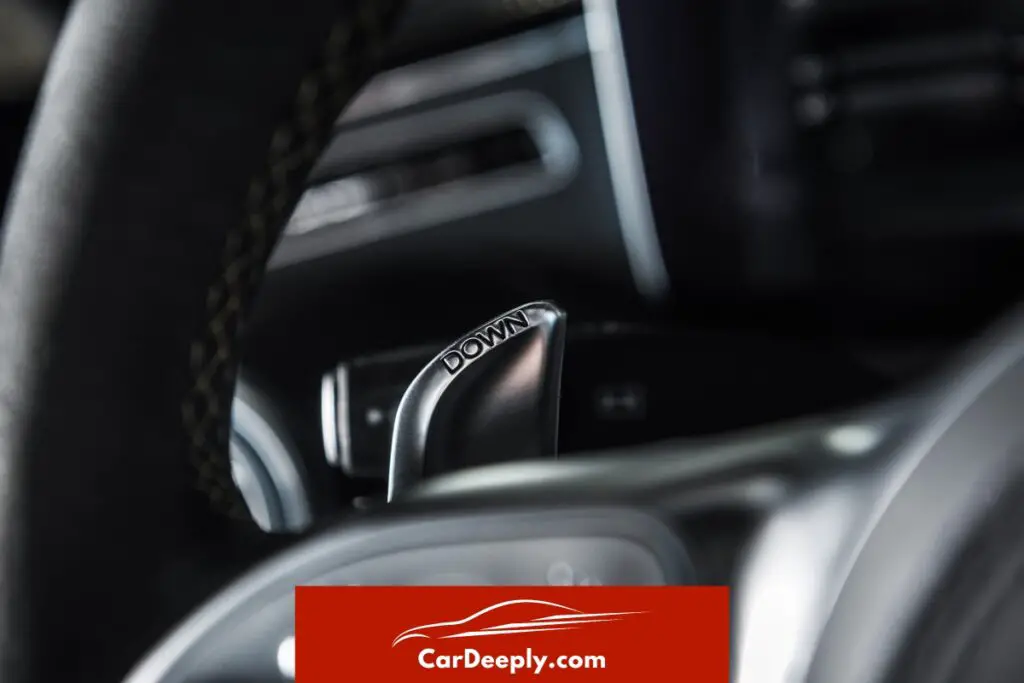Driving with paddle shifters can be exhilarating, but can they ruin your transmission? This comprehensive guide will put your worries to rest.
We’ve delved into the mechanics of paddle shifters, consulted with automotive experts, and gathered insights from reliable sources. You’ll learn about the function of paddle shifters, how they interact with your car’s transmission, and the precautions you need to take.
Here’s a sneak peek: You’ll discover the truth about the impact of paddle shifters on your transmission, learn practical tips to avoid potential damage, and gain insights into the myths surrounding paddle shifters.
Buckle up, and let’s shift gears into the world of paddle shifters!
Advertising links are marked with *. We receive a small commission on sales, nothing changes for you.
Key Takeaways

- Paddle shifters allow manual gear shifting in automatic cars.
- The car’s computer system prevents harmful gear shifts.
- Paddle shifters are safe and won’t damage your transmission.
- Correct usage of paddle shifters enhances the driving experience.
- Practice is key to mastering paddle shifters.
What are Paddle Shifters?
Paddle shifters, those little levers behind the steering wheel, are more than just fancy car accessories. They’re a bridge between manual and automatic transmissions, offering drivers the thrill of manual gear shifting without the hassle of a clutch.
Here’s how they work:
- Definition and Purpose: Paddle shifters are levers on the steering wheel that allow drivers to shift gears in an automatic car manually. They offer a more engaging driving experience, giving you control over gear shifts and engine RPM.
- Operation: When you pull on a paddle, it sends a signal to the car’s computer. If the computer agrees with your shift (based on factors like engine speed and load), it will initiate the gear change.
What is a Transmission?
The transmission is the unsung hero of your vehicle. It transfers power from the engine to the wheels, making movement possible. Here’s what you need to know:
- Role of Transmission: The transmission adjusts the power output of the engine to drive the wheels at the right speed. It does this by changing gear ratios.
- Manual vs. Automatic: The driver manually selects and engages gears in a manual transmission. In an automatic transmission, the car does this for you. Paddle shifters bring a touch of manual control to automatic transmissions.
The Connection Between Paddle Shifters and Transmissions
Paddle shifters and transmissions are two sides of the same coin. They work together to deliver a smooth and enjoyable driving experience.
- Interaction: When using a paddle shifter, you directly interact with the transmission. You’re telling it when to change gears, giving you more control over your vehicle’s performance.
- Role of the Computer: The car’s computer plays a crucial role in this process. It ensures that your gear shifts won’t damage the engine or transmission, overriding shifts that could harm the vehicle.
In the next part, we’ll delve deeper into the question: Can paddle shifters ruin your transmission? Stay tuned!
Can Paddle Shifters Ruin Your Transmission?
The Myth: Paddle Shifters and Transmission Damage
There’s a common misconception that paddle shifters can damage your transmission.
This myth likely stems from the fact that manual shifting, if done incorrectly, can indeed harm your transmission. But here’s the catch: paddle shifters in automatic cars are designed to prevent such damage.
The Reality: Safety Mechanisms in Modern Cars
Modern cars are equipped with computer systems that prevent harmful gear shifts. These safety measures protect your transmission, even when manually shifting with paddle shifters.
Here’s how:
- Computer Controls: The car’s computer won’t allow a gear shift that could damage the engine or transmission. For instance, it won’t let you shift to a lower gear if your speed is too high.
- Safety Measures: If a requested shift could harm the vehicle, the computer will ignore the request. This means you can enjoy the experience of manual shifting without the risk of damaging your transmission.
Practical Tips for Using Paddle Shifters
While paddle shifters are designed to be safe, it’s still important to use them correctly. Here are some tips to keep in mind:
- Don’t Force Shifts: If the computer doesn’t allow a shift, there’s a good reason for it. Don’t try to force the shift by repeatedly pulling the paddle.
- Use Appropriate Gears: Use lower gears for lower speeds and higher gears for higher speeds. This will ensure optimal performance and fuel efficiency.
- Practice Makes Perfect: If you’re new to paddle shifters, practice in a safe environment until you’re comfortable with manual shifting.
FAQs
What happens if I try to force a shift with paddle shifters?
If you try to force a shift that the car’s computer deems unsafe, it will simply ignore the request. This safety feature prevents potential damage to the engine or transmission.
Can I use paddle shifters in any automatic car?
Not all automatic cars come with paddle shifters. They are usually found in sports cars or high-end models. Check your vehicle’s manual or consult with the manufacturer to confirm.
Do paddle shifters improve fuel efficiency?
Paddle shifters themselves don’t improve fuel efficiency. However, if used correctly, they allow more control over gear shifts, leading to more efficient driving habits.
Can I switch between automatic and manual shifting while driving?
es, you can switch between automatic and manual shifting while driving. However, doing so is recommended when the vehicle is not under heavy load, such as during steady cruising.
Are paddle shifters only for high-speed driving?
No, paddle shifters can be used at any speed. They offer a more engaging driving experience, regardless of how fast you’re going.
Conclusion
Paddle shifters are a fun and safe way to experience manual shifting in an automatic car. They’re designed to prevent damage to your transmission, and with a little practice, you can use them to enhance your driving experience.
So go ahead, give those paddles a pull!

Sebastian loves convertibles and drove a BMW 335i for a long time (325 hp is just a dream). Today, with two children, he is more concerned with SUVs and family-friendly vehicles. In addition to an Audi A4 Avant, he also drives a Cupra Formentor VZ – even as a family man, you can’t do without speed. Get to know Sebastian better and visit the About Us page.
Advertising links are marked with *. We receive a small commission on sales, nothing changes for you.
